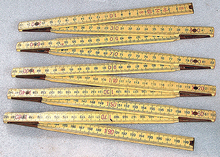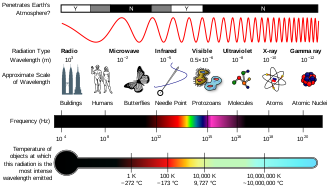Centimetre
| centimetre | |
|---|---|
 A carpenter's ruler with centimetre divisions | |
| General information | |
| Unit system | SI |
| Unit of | length |
| Symbol | cm |
| Conversions | |
| 1 cm in ... | ... is equal to ... |
| millimetres | 10 mm |
| imperial & US system | ~0.3937 in |

A centimetre (international spelling) or centimeter (American spelling) (SI symbol cm) is a unit of length in the International System of Units (SI), equal to one hundredth of a metre, centi being the SI prefix for a factor of 1/100.[1] Equivalently, there are 100 centimetres in 1 metre. The centimetre was the base unit of length in the now deprecated centimetre–gram–second (CGS) system of units.
Though for many physical quantities, SI prefixes for factors of 103—like milli- and kilo-—are often preferred by technicians, the centimetre remains a practical unit of length for many everyday measurements; for instance, human height is most commonly measured in centimetres.[2][3] A centimetre is approximately the width of the fingernail of an average adult person.
Equivalence to other units of length
1 centimetre = 10 millimetres = 0.01 metres = 0.393700787401574803149606299212598425196850 inches (There are exactly 2.54 centimetres in one inch.)
One millilitre is defined as one cubic centimetre, under the SI system of units.
Other uses
In addition to its use in the measurement of length, the centimetre is used:
- sometimes, to report the level of rainfall as measured by a rain gauge[4]
- in the CGS system, the centimetre is used to measure capacitance, where 1 cm of capacitance = 1.113×10−12 farads[5]
- in maps, centimetres are used to make conversions from map scale to real world scale (kilometres)
- to represent second moment of areas (cm4)
- as the inverse of the Kayser, a CGS unit, and thus a non-SI metric unit of wavenumber: 1 kayser = 1 wave per centimetre; or, more generally, (wavenumber in kaysers) = 1/(wavelength in centimetres). The SI unit of wavenumber is the inverse metre, m−1.
Unicode symbols
For the purposes of compatibility with Chinese, Japanese and Korean (CJK) characters, Unicode has symbols for:[6]
- centimetre – U+339D ㎝ SQUARE CM
- square centimetre – U+33A0 ㎠ SQUARE CM SQUARED
- cubic centimetre – U+33A4 ㎤ SQUARE CM CUBED
They are mostly used only with East Asian fixed-width CJK fonts, because they are equal in size to one Chinese character.
See also
References
- ^ "Decimal multiples and submultiples of SI units". Bureau International des Poids et Mesures. 2014. Retrieved 5 July 2015.
- ^ "Using the BMI-for-Age Growth Charts". cdc.gov. Centers for Disease Control. Archived from the original on 30 January 2014. Retrieved 5 July 2014.
- ^ Price, Beth; et al. (2009). MathsWorld Year 8 VELS Edition. Australia: MacMillan. p. 626. ISBN 978-0-7329-9251-4.
- ^ "Rain Measurement". www.weathershack.com.
- ^ Weisstein, Eric W. "Capacitance -- from Eric Weisstein's World of Physics". scienceworld.wolfram.com.
- ^ CJK Compatibility excerpt from The Unicode Standard, Version 10.0.
